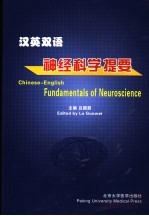

神经科学提要 汉英双语PDF电子书下载
- 电子书积分:10 积分如何计算积分?
- 作 者:吕国蔚主编
- 出 版 社:北京:北京大学医学出版社
- 出版年份:2005
- ISBN:781071757X
- 页数:243 页
第一篇 神经系统基本构成 3
第一章 神经系统的组成 3
一、神经系统的主要分类 3
二、中枢神经系统的局部解剖 3
目录 3
三、脑的解剖 4
四、脊髓的解剖 8
五、中枢神经系统的被膜和血管组成 9
第二章 神经组织的组织学 11
一、神经组织的特性 11
二、神经系统的细胞类型 11
三、神经细胞形态学 11
四、神经胶质细胞形态学 12
六、突触 13
五、室管膜细胞 13
七、神经细胞的基本结构 14
第二篇 神经细胞的基本活动 15
第一章 轴突传导 15
一、神经元功能 15
二、静息电位 15
三、动作电位 16
四、动作电位的离子基础 17
五、动作电位的分子机制 18
六、动作电位的不应期 18
七、动作电位的传导 19
八、复合动作电位的传导 20
二、肌纤维结构 21
第二章 肌肉收缩 21
一、肌肉的功能 21
三、骨骼肌类型 22
四、兴奋—收缩偶联 22
五、肌肉力学 23
六、肌肉做功 23
七、肌肉能量学 24
第三章 突触传递 25
一、突触的功能 25
二、化学传递 25
三、递质释放 26
四、递质物质 27
五、递质的作用 27
八、突触前抑制 28
六、突触的兴奋作用 28
七、突触后抑制 28
九、神经效应器通讯 29
十、电突触 29
第三篇 神经系统主要功能 30
第一章 躯体感觉 30
一、引言 30
二、感觉性感受器刺激引起的连续活动 30
三、躯体感觉的解剖基础 31
四、意识性本体感觉和分辨觉 33
五、疼痛 34
六、意识性通路小结 35
二、导致肌肉收缩的一系列活动 37
一、引言 37
第二章 运动调控 37
三、运动控制的解剖基础 38
四、反射活动 42
五、姿势 44
六、行走运动 45
七、随意运动 45
第三章 自主调节 46
一、引言 46
二、导致神经效应器活动的系列事件 47
三、自主机能的解剖特点 48
四、自主反射 49
五、内脏活动的双重调节 50
六、自稳态 51
七、情绪与驱动 52
第四章 高级机能 53
一、引言 53
二、大脑皮层的电活动 53
三、与高级机能有关的解剖基础 54
四、学习和记忆 55
五、睡眠一清醒周期 56
六、意识和语言 57
第四篇 特殊感官感觉活动 58
第一章 视觉 58
一、眼的结构 58
二、视觉光学 58
三、视网膜机制 61
四、视觉中枢通路 63
五、视觉反射 64
六、人类视觉 65
第二章 听觉 66
一、声波的物理特性 66
二、耳的结构 67
三、听觉力学 68
四、耳蜗的机制 68
五、听觉中枢通路 69
六、人的听觉 69
七、听觉信息的编码 70
八、听觉试验 71
第三章 平衡觉 71
一、迷路的功能解剖 71
二、感觉转换器 72
四、前庭刺激效应 73
三、前庭迷路的中枢联系 73
第四章 嗅觉 75
一、嗅觉解剖 75
二、气味分辨的生理学基础 75
三、嗅觉通路 75
四、临床意义 76
第五章 味觉 76
一、味觉解剖 76
二、兴奋机制 76
三、味觉通路 76
四、味觉感觉 77
词汇表 78
Ⅱ.Regional Anatomy of the CNS 125
Ⅰ.Major Division of the Nervous System 125
Contents 125
Chapter 1 Organization of the Nervous System 125
Part Ⅰ Basic Structure of the Nervous System 125
Ⅲ.Anatomy of the Brain 126
Ⅳ.Anatomy of the Spinal Cord 130
Ⅴ.Coverings and Vascularization of the Central Nervous System 131
Chapter 2 Histology of Nervous Tissue 133
Ⅰ.Properties of Nervous Tissue 133
Ⅱ.Nervous System Cell Types 133
Ⅲ.Nerve Cell Morphology 133
Ⅳ.Neuroglia Cell Morphology 134
Ⅴ.Ependymal Cells 135
Ⅵ.The Synapse 135
Ⅶ.Basic Structure of the Nerve cell(summary) 137
Part Ⅱ Fundamental Activity of Nerve Cells 138
Chapter 1 Axonal Conduction 138
Ⅰ.Neuronal Function 138
Ⅱ.Resting Potential 138
Ⅲ.Action Potential 139
Ⅳ.Ionic Basis of Action potential 141
Ⅴ.Molecular Mechanism of Action Potential 142
Ⅵ.Refractory Periods 142
Ⅶ.Propagation of Action Potential 143
Ⅷ.Conduction of Compound Action potential 144
Chapter 2 Muscular Contraction 145
Ⅰ.Muscular Function 145
Ⅱ.Muscle Fiber Structure 146
Ⅲ.Types of Skeletal Muscles 147
Ⅳ.Excitation-Contraction Coupling 147
Ⅴ.Muscle Mechanics 148
Ⅵ.Muscular Work 148
Ⅶ.Muscle Energetics 149
Chapter 3 Synaptic Transmission 150
Ⅰ.Synaptic Function 150
Ⅱ.Chemical Transmission 151
Ⅲ.Transmitter Release From Presynaptic Element 152
Ⅳ.Transmitter Substances 152
Ⅴ.Transmitter Activities 153
Ⅶ.Postsynaptic Inhibition 154
Ⅵ.Synaptic Excitatory Action 154
Ⅷ.Presynaptic Inhibition 155
Ⅸ.Neuroeffector Communication 155
Ⅹ.Electrical Synapse 156
Part Ⅲ Essential Function of the Nervous System 157
Chapter 1 Somatic Sense 157
Ⅰ.Introduction 157
Ⅱ.Successive Events upon Stimulation of a Sensory Receptor 157
Ⅲ.Anatomical Substrates for Somatic Sensation 158
Ⅳ.Conscious Proprioception and Discrimination 160
Ⅴ.Pain 161
Ⅵ.Summary of Conscious Pathways 164
Chapter 2 Motor control 165
Ⅰ.Introduction 165
Ⅲ.Anatomical Substrates for Motor Control 166
Ⅱ.Sequence of Events Leading to a Contraction of Muscles 166
Ⅳ.Reflex Action 172
Ⅴ.Posture 174
Ⅵ.Locomotion 176
Ⅶ.Voluntary Movements 177
Chapter 3 Autonomic Regulation 178
Ⅰ.Introduction 178
Ⅱ.Sequence of Events Leading to an Activity in Neuroeffectors 178
Ⅲ.Anatomical Aspects for Autonomic Functions 180
Ⅳ.Autonomic Reflexes 182
Ⅴ.Dual Regulation of Visceral Activity 182
Ⅵ.Homeostasis 184
Ⅶ.Emotion and Motivation 185
Chapter 4 Higher Function 186
Ⅰ.Introduction 186
Ⅱ.Electrical Activity of the Cerebral Cortex 186
Ⅲ.Anatomical Substrates Related to the Higher Function 187
Ⅳ.Learning and Memory 189
Ⅴ.Sleep-Wake Cycle 191
Ⅵ.Consciousness and Language 192
Part Ⅳ Sensory Action of Special Sense Organs 193
Chapter 1 Vision 193
Ⅰ.Structure of the Eye 193
Ⅱ.Visual Optics 194
Ⅲ.Retinal Mechanisms 196
Ⅳ.Central Visual Pathways 200
Ⅴ.Visual Reflexes 201
Ⅵ.Vision in Man 202
Chapter 2 Hearing 204
Ⅰ.Physical Properties of Sound Waves 204
Ⅱ.Structure of the Ear 204
Ⅲ.Auditory Mechanics 206
Ⅳ.Cochlear Mechanisms 207
Ⅴ.Auditory Central Pathways 208
Ⅵ.Hearing in Man 208
Ⅶ.Coding of Auditory Information 209
Ⅷ.Hearing Tests 210
Chapter 3 Sense of Balance 211
Ⅰ.Functional Anatomy of Labyrinth 211
Ⅱ.Sensory Transducers 211
Ⅲ.Central Connections of the Vestibular Labyrinth 212
Ⅳ.Effects of Vestibular Stimulation 213
Chapter 4 Smell 215
Ⅰ.Anatomy of Smell 215
Ⅱ.Physiological Basis for Discrimination of Odors 215
Ⅲ.Pathways of Smell 216
Ⅳ.Clinical Significance 216
Chapter 5 Taste 216
Ⅰ.Anatomy of Taste 216
Ⅱ.Mechanism of Stimulation 217
Ⅲ.Pathways of Taste 217
Ⅳ.Taste Sensation 217
Glossary 219
References 243
- 《《走近科学》精选丛书 中国UFO悬案调查》郭之文 2019
- 《卓有成效的管理者 中英文双语版》(美)彼得·德鲁克许是祥译;那国毅审校 2019
- 《中医骨伤科学》赵文海,张俐,温建民著 2017
- 《美国小学分级阅读 二级D 地球科学&物质科学》本书编委会 2016
- 《强磁场下的基础科学问题》中国科学院编 2020
- 《小牛顿科学故事馆 进化论的故事》小牛顿科学教育公司编辑团队 2018
- 《小牛顿科学故事馆 医学的故事》小牛顿科学教育公司编辑团队 2018
- 《新闻走向科学》吴勤如著 1992
- 《中华医学百科全书 中医内科学》(中国)刘德培 2019
- 《科学令人如此开怀 电磁的魔力》纸上魔方 2017
- 《大学计算机实验指导及习题解答》曹成志,宋长龙 2019
- 《指向核心素养 北京十一学校名师教学设计 英语 七年级 上 配人教版》周志英总主编 2019
- 《大学生心理健康与人生发展》王琳责任编辑;(中国)肖宇 2019
- 《大学英语四级考试全真试题 标准模拟 四级》汪开虎主编 2012
- 《大学英语教学的跨文化交际视角研究与创新发展》许丽云,刘枫,尚利明著 2020
- 《北京生态环境保护》《北京环境保护丛书》编委会编著 2018
- 《复旦大学新闻学院教授学术丛书 新闻实务随想录》刘海贵 2019
- 《大学英语综合教程 1》王佃春,骆敏主编 2015
- 《大学物理简明教程 下 第2版》施卫主编 2020
- 《医学物理学》洪洋 2020
